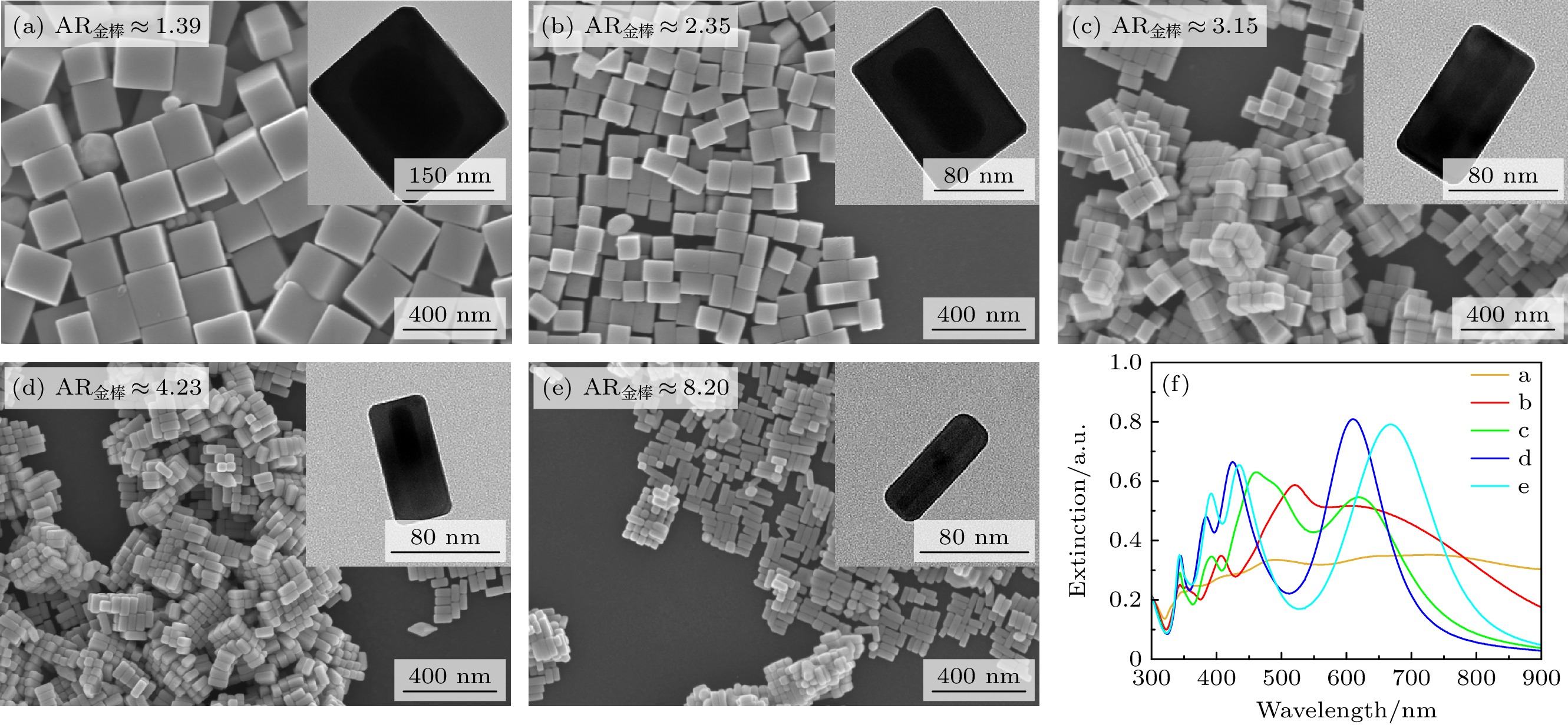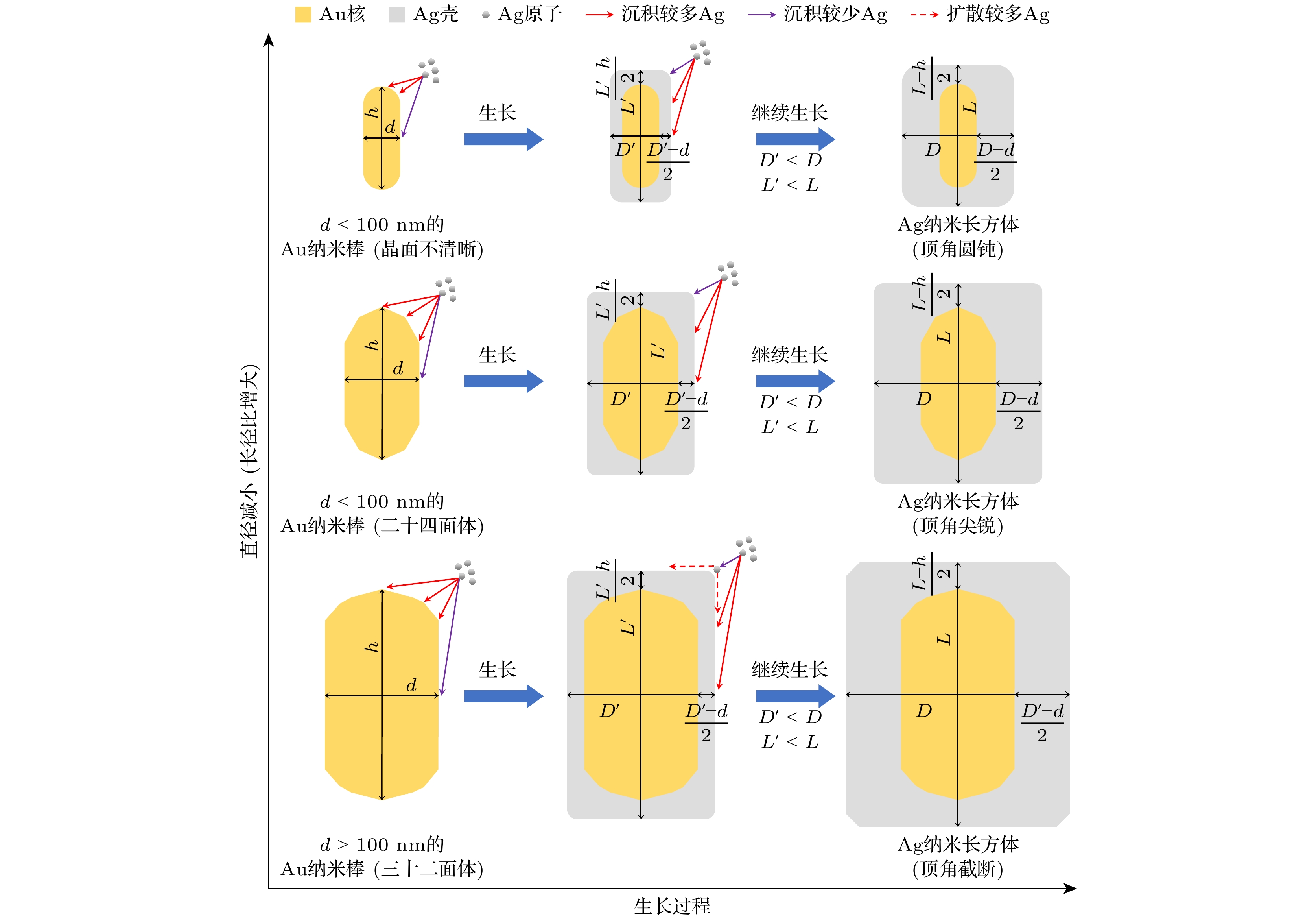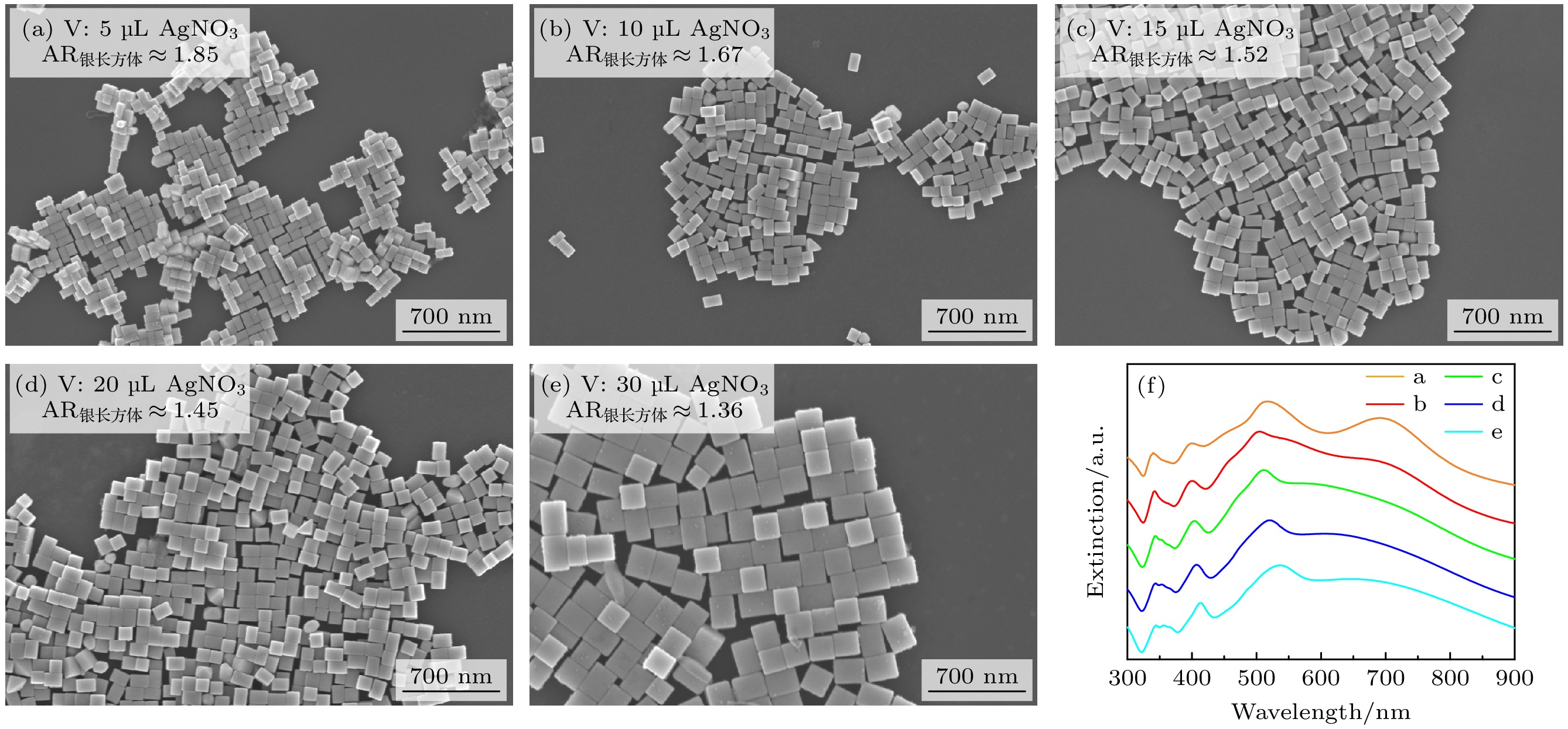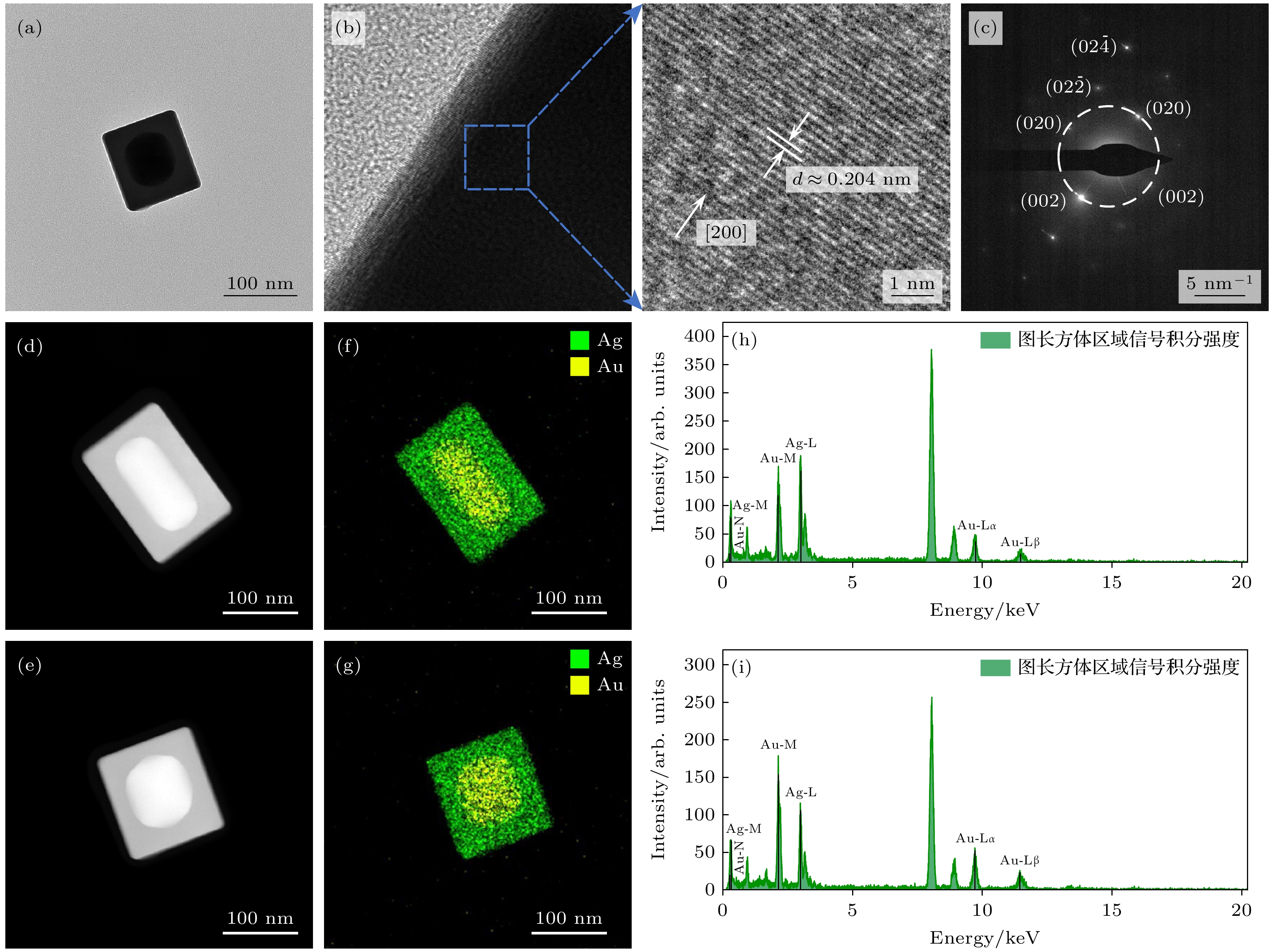-
金核银壳(Au@Ag)纳米颗粒兼具金的稳定性、生物相容性及银的优异电磁响应特性, 在纳米医学、环境保护、传感和光学等领域具有重要应用价值. Au@Ag纳米长方体因其结构的各向异性, 特别是表面等离激元共振(SPR)效应, 在基础科学研究中扮演着重要角色. 本研究通过晶种法, 即在水相中调控Au纳米棒种子的尺寸、长径比(AR)及Ag前驱体用量, 制备了形貌、尺寸与光学性质均可控的Au@Ag纳米长方体. 实验表明, 当Au纳米棒直径大于100 nm时, Au@Ag纳米长方体的顶角出现截断; 当Au纳米棒直径小于100 nm时, Au@Ag纳米长方体的顶角随Au纳米棒AR的减小而变得更尖(~90°). 值得注意的是, 当Au纳米棒的AR在一定范围内(~1.39—3.15)时, 均可生长形貌良好(顶角尖锐)的Au@Ag纳米长方体, 这一发现为研究纳米长方体顶角的变化提供了一定参考. 另外, 纳米长方体的长度(~110 nm—141 nm)与宽度(~60 nm—104 nm)可通过调节硝酸银的量实现精准调控. 同时, 模拟计算结果表明, 相对于纳米棒而言, Au@Ag纳米长方体不仅具有丰富的多级SPR模式, 其尖角可产生巨大的电场增强. 本研究进一步拓展了其在多个高科技产业中的应用前景.
-
关键词:
- 晶种法 /
- Au@Ag纳米长方体 /
- 形貌 /
- 表面等离激元共振
Au@Ag core-shell nanoparticles have emerged as a promising platform for photonic applications due to their synergistic integration of gold’s biocompatibility and silver’s exceptional plasmonic properties. And nanoparticles with sharp corners exhibit electron accumulation at the tips under electromagnetic fields, generating enhanced localized electric fields. This phenomenon facilitates their applications in fields such as surface-enhanced Raman spectroscopy and strong coupling interactions. So, when Au@Ag core-shell nanoparticles possess sharp corners, they will exhibit excellent performance in trace molecule detection, biosensing, and catalytic applications. By using gold nanorod (AuNR) seeds with different dimensions and adjusting the volume of silver precursors, the seed-mediated synthesis of Au@Ag nanocuboids with adjustable morphology, size and surface plasmon resonance is systematically investigated in this work. Key synthesis parameters, including AuNR diameters, aspect ratios, and AgNO3 volumes, are modulated to realize the morphological, size and optical control. In experiments of adjusting the size of AuNR seeds for synthesizing Au@Ag nanocuboids, as the diameter of AuNR decreases from (136.5 ± 5) nm to (11.2 ± 2) nm and its aspect ratio increases from 1.39 to 8.20, the aspect ratio of Au@Ag nanocuboids increases from 1.18 to 2.69. Notably, when the diameter of AuNR is below 100 nm, the sharpness of the corners of Au@Ag nanocuboids is progressively improved with the increase of diameter and decrease of aspect ratio of the AuNRs. However, when the AuNR diameter exceeds 100 nm, the corners of the synthesized Au@Ag nanocuboids exhibit truncation. Meanwhile, the extinction spectrum reveals that apart from the broadened and indistinct peaks caused by the size effect, Au@Ag nanocuboids can primarily excite the longitudinal plasmon resonance mode, transverse plasmon resonance mode, and octupolar plasmon resonance modes. Furthermore, the plasmon resonance peaks exhibit corresponding shifts in response to changes in the size and morphology of Au@Ag nanocuboids. Meanwhile, neither the characterization results of high-resolution transmission electron microscopy nor selected area electron diffraction shows {111} crystal planes, indicating that the Au@Ag nanocuboids with the sharpest corners are not truncated and exhibits an exceptional morphology. And the results from high-angle annular dark-field scanning transmission electron microscopy combined with energy-dispersive X-ray spectroscopy reveal that the silver shell exhibits anisotropic growth features on the gold core, with its transverse thickness being significantly greater than the longitudinal thickness. Besides, Au@Ag nanocuboids’ dimensions are linearly regulated by the volume of AgNO3 (100 mmol/L) from 5 μL to 30 μL, yielding tunable lengths ((110.3 ± 7.8) nm to (141.3 ± 5.5) nm), widths ((59.7 ± 2.1) nm to (103.7 ± 5.6) nm), aspect ratios (1.85 to 1.36) and corresponding plasmon resonance peaks as validated by SEM and extinction spectrum. The simulation results of their extinction spectra are in better agreement with the experimental measurements. For the nanocuboid with an aspect ratio of 1.45, as the sharpness of the top corners decreases (r/L = 0.2%–11.5%), the strength of the electric field at the corners shows a trend of first increasing and then decreasing, with the maximum electric field enhancement observed at r/L = 0.5%. This work synthesizes Au@Ag nanocuboids with controllable sharpness of corners and dimension by adjusting the size and aspect ratio of AuNRs or changing the quantity of silver precursors. The method proposed in this study for synthesizing sharp-cornered Au@Ag nanocuboids provides possibilities for customized fabrication of Au@Ag nanocuboids, thereby expanding their application prospects in nanophotonics, catalysis, sensing, photothermal therapy and other fields. -
Keywords:
- seed-mediated synthesis /
- Au@Ag nanocuboids /
- morphology /
- surface plasmon resonance
[1] Mendez E, Fagundez P, Sosa P, Gutierrez M V, Botasini S 2021 Nanotechnology 32 045603
 Google Scholar
Google Scholar
[2] Bi C X, Yin X L, Zhao H Y 2024 RSC Adv. 14 20145
 Google Scholar
Google Scholar
[3] 熊磊, 丁洪伟, 李光元 2022 物理学报 71 047802
 Google Scholar
Google Scholar
Xiong L, Ding H W, Li G Y 2022 Acta Phys. Sin. 71 047802
 Google Scholar
Google Scholar
[4] Lee D, Yoon S 2016 J. Phys. Chem. C 120 20642
 Google Scholar
Google Scholar
[5] McLellan J M, Siekkinen A, Chen J, Xia Y 2006 Chem. Phys. Lett. 427 122
 Google Scholar
Google Scholar
[6] Rycenga M, Camargo P H, Li W, Moran C H, Xia Y 2010 J. Phys. Chem. Lett. 1 696
 Google Scholar
Google Scholar
[7] Zhong J, Li J Y, Liu J, Xiang Y F, Feng H, Liu R M, Li W, Wang X H 2024 Nano Lett. 24 1579
 Google Scholar
Google Scholar
[8] Li J Y, Wang Q Q, Wang J, Li M, Zhang X, Luan L L, Li P, Xu W P 2021 Anal. Bioanal. Chem. 413 4207
 Google Scholar
Google Scholar
[9] Lin S, Guan H Y, Liu Y Q, Huang S N, Li J M, Hasi W, Xu Y Z, Zou J X, Dong B 2021 ACS Appl. Mater. Interfaces 13 53289
 Google Scholar
Google Scholar
[10] Ma Y Y, Li W Y, Cho E C, Li Z Y, Yu T, Zeng J, Xie Z X, Xia Y N 2010 ACS Nano 4 6725
 Google Scholar
Google Scholar
[11] Liu K K, Tadepalli S, Tian L, Singamaneni S 2015 Chem. Mater. 27 5261
 Google Scholar
Google Scholar
[12] Xing C C, Zhong S C, Yu J, Li X J, Cao A, Men D D, Wu B, Cai W P, Li Y 2020 J. Mater. Chem. C 8 3838
 Google Scholar
Google Scholar
[13] Cho E C, Camargo P H C, Xia Y N 2010 Adv. Mater. 22 744
 Google Scholar
Google Scholar
[14] Zheng Y Q, Zhong X L, Li Z Y, Xia Y N 2013 Part. Part. Syst. Char. 31 266
 Google Scholar
Google Scholar
[15] Sanchez-Iglesias A, Winckelmans N, Altantzis T, Bals S, Grzelczak M, Liz-Marzan L M 2017 J. Am. Chem. Soc. 139 107
 Google Scholar
Google Scholar
[16] Park J E, Lee Y, Nam J M 2018 Nano Lett. 18 6475
 Google Scholar
Google Scholar
[17] Lin S, Lin X, Han S, He L, Zhao H Y, Zhang J, Hasi W, Wang L 2019 J. Alloys Compd. 805 318
 Google Scholar
Google Scholar
[18] Okuno Y, Nishioka K, Kiya A, Nakashima N, Ishibashi A, Niidome Y 2010 Nanoscale 2 1489
 Google Scholar
Google Scholar
[19] Park K, Drummy L F, Vaia R A 2011 J. Mater. Chem. 21 15608
 Google Scholar
Google Scholar
[20] Tebbe M, Kuttner C, Mayer M, Maennel M, Pazos-Perez N, König T A F, Fery A 2015 J. Phys. Chem. C 119 9513
 Google Scholar
Google Scholar
[21] Fu N Q, Bao Z Y, Zhang Y L, Zhang G G, Ke S M, Lin P, Dai J Y, Huang H T, Lei D Y 2017 Nano Energy 41 654
 Google Scholar
Google Scholar
[22] Vernier C, Portalès H 2024 J. Chem. Phys. 161 124711
 Google Scholar
Google Scholar
[23] Hamon C, Constantin D 2020 J. Phys. Chem. C 124 21717
 Google Scholar
Google Scholar
[24] Chang S T, Dong W Y, Chen K C, He Y, Yen Y A, Kao C W, Deng J P 2021 J. Chin. Chem. Soc. 68 512
 Google Scholar
Google Scholar
[25] He B W, Liu X, Chen L W 2023 Nano Lett. 23 3963
 Google Scholar
Google Scholar
[26] Gómez-Graña S, Goris B, Altantzis T, Fernández-López C, Carbó-Argibay E, Guerrero-Martínez A, Almora-Barrios N, López N, Pastoriza-Santos I, Pérez-Juste J, Bals S, Van Tendeloo G, Liz-Marzán L M 2013 J. Phys. Chem. Lett. 4 2209
 Google Scholar
Google Scholar
[27] Ye X C, Zheng C, Chen J, Gao Y Z, Murray C B 2013 Nano Lett. 13 765
 Google Scholar
Google Scholar
[28] Vigderman L, Zubarev E R 2013 Chem. Mater. 25 1450
 Google Scholar
Google Scholar
[29] Thambi V, Kar A, Ghosh P, Paital D, Gautam A R S, Khatua S 2019 ACS Omega 4 13733
 Google Scholar
Google Scholar
[30] da Silva J A, Netz P A, Meneghetti M R 2025 J. Chem. Inf. Model. 65 2730
 Google Scholar
Google Scholar
[31] da Silva J A, Netz P A, Meneghetti M R 2020 Langmuir 36 257
 Google Scholar
Google Scholar
[32] Jing H, Zhang Q, Large N, Yu C, Blom D A, Nordlander P, Wang H 2014 Nano Lett. 14 3674
 Google Scholar
Google Scholar
[33] Jiang R B, Chen H J, Shao L, Li Q, Wang J F 2012 Adv. Mater. 24 OP200
 Google Scholar
Google Scholar
[34] Hamasaki Y, Nakashima N, Niidome Y 2012 J. Phys. Chem. C 117 2521
 Google Scholar
Google Scholar
[35] Xia Y, Xia X, Peng H C 2015 J. Am. Chem. Soc. 137 7947
 Google Scholar
Google Scholar
[36] Herrmann L O, Baumberg J J 2013 Small 9 3743
 Google Scholar
Google Scholar
[37] König T, Kodiyath R, Combs Z A, Mahmoud M A, El-Sayed M A, Tsukruk V V 2013 Part. Part. Syst. Char. 31 274
 Google Scholar
Google Scholar
[38] Liu M, Pang Y, Zhang B, De Luna P, Voznyy O, Xu J, Zheng X, Dinh C T, Fan F, Cao C, de Arquer F P G, Safaei T S, Mepham A, Klinkova A, Kumacheva E, Filleter T, Sinton D, Kelley S O, Sargent E H 2016 Nature 537 382
 Google Scholar
Google Scholar
[39] Pena-Rodriguez O, Diaz-Nunez P, Gonzalez-Rubio G, Manzaneda-Gonzalez V, Rivera A, Perlado J M, Junquera E, Guerrero-Martinez A 2020 Sci. Rep. 10 5921
 Google Scholar
Google Scholar
[40] Guo P, Sikdar D, Huang X, Si K J, Xiong W, Gong S, Yap L W, Premaratne M, Cheng W 2015 Nanoscale 7 2862
 Google Scholar
Google Scholar
[41] Tan S F, Wu L, Yang J K W, Bai P, Bosman M, Nijhuis C A 2014 Science 343 1496
 Google Scholar
Google Scholar
[42] Pramod P, Thomas K G 2008 Adv. Mater. 20 4300
 Google Scholar
Google Scholar
[43] Li N, Han Z H, Huang Y M, Liang K, Wang X F, Wu F, Qi X Y, Shang Y X, Yu L, Ding B Q 2020 J. Mater. Chem. C 8 7672
 Google Scholar
Google Scholar
[44] Hu H T, Zhang S P, Xu H X 2019 Phys. Rev. A 99 033815
 Google Scholar
Google Scholar
[45] Lee Y M, Kim S E, Park J E 2023 Nano Converg. 10 34
 Google Scholar
Google Scholar
[46] Yang X Z, Li J, Zhao Y X, Yang J H, Zhou L Y, Dai Z G, Guo X, Mu S J, Liu Q Z, Jiang C M, Sun M T, Wang J F, Liang W J 2017 Nanoscale 10 142
 Google Scholar
Google Scholar
[47] Li Y, Zhang Y H, Xu J, Kan C X, Li Z S, Shi D N 2024 CrystEngComm 26 5799
 Google Scholar
Google Scholar
[48] Yang T H, Ahn J, Shi S, Wang P, Gao R, Qin D 2021 Chem. Rev. 121 796
 Google Scholar
Google Scholar
-
图 1 不同长径比(AR金棒)Au纳米棒作为种子合成Au@Ag纳米长方体及相应消光光谱图 (a)—(e) 分别用AR金棒 ≈ 1.39, 2.35, 3.15, 4.23 和 8.20 依次生长AR银长方体 ≈ 1.18, 1.45, 1.69, 2.19 和 2.69 的Au@Ag纳米长方体SEM图和相应的TEM (插图); SEM图(a)—(e)比例尺均为400 nm, TEM插图(a)比例尺为150 nm, TEM插图(b)—(e)比例尺均为80 nm; (f) 图(a)—(e)对应的消光光谱图
Fig. 1. Synthesis of Au@Ag nanocuboids using gold nanorods with different aspect ratios (ARAuNR) as seeds and their corresponding extinction spectra: (a)–(e) SEM images of Au@Ag nanocuboids with ARAgNCB ≈ 1.18, 1.45, 1.69, 2.19 and 2.69, grown from ARAuNR ≈ 1.39, 2.35, 3.15, 4.23 and 8.20, respectively, along with corresponding TEM insets. Scale bars in SEM images (a)–(e) are 400 nm, with the TEM inset in (a) being 150 nm and those in (b)–(e) being 80 nm. (f) Extinction spectra corresponding to panel (a)–(e).
图 2 不同晶面类型的Au纳米棒作为种子对生长Au@Ag纳米长方体顶角的影响机制, 图中d和h为Au纳米棒直径和长度; D′和L′为生长较薄银壳时Au@Ag纳米长方体宽度和长度; D和L为生长结束时Au@Ag纳米长方体宽度和长度, 其中(D – d)/2 $ \gg $(L – h)/2
Fig. 2. Growth mechanism of Au@Ag nanocuboid corners mediated by Au nanorod seeds with different crystallographic facets. In the figure, d and h represent the diameter and length of the Au nanorod, respectively; D′ and L′ denote the width and length of the Au@Ag nanocuboids immediately after the initial growth of a silver shell layer; D and L correspond to the final width and length of the Au@Ag nanocuboids after complete silver shell growth. Here (D – d)/2$ \gg $ (L – h)/2.
图 3 在Au纳米棒(图1(b), AR金棒 ≈ 2.35)溶液中加入不同体积的AgNO3, 生长不同尺寸的Au@Ag纳米长方体及相应的消光光谱图 (a)—(e) 5 μL, 10 μL, 15 μL, 20 μL 和 30 μL AgNO3生长的Au@Ag纳米长方体(相应的AR银长方体 ≈ 1.85, 1.67, 1.52, 1.45 和 1.36) SEM图, 其中图(a)—(e)比例尺均为700 nm; (f) 图(a)—(e)对应的消光光谱图, 为了清晰起见, 谱线设置了垂直偏移
Fig. 3. Growth of Au@Ag nanocuboids with varying sizes by adding different volumes of AgNO3 to the gold nanorods solution (Fig. 1(b), ARAuNR ≈ 2.35) and their corresponding extinction spectra: (a)–(e) SEM images of Au@Ag nanocuboids with ARAgNCB ≈ 1.85, 1.67, 1.52, 1.45 and 1.36, respectively, synthesized using 5 μL, 10 μL, 15 μL, 20 μL and 30 μL AgNO3 correspondingly, where scale bars in panel (a)–(e) are 700 nm; (f) extinction spectra of panel (a)–(e), with spectra curves vertically offset for clarity.
图 4 (a) 不同AR的Au@Ag纳米长方体消光光谱的计算结果; (b) AR为1.45的Au@Ag纳米长方体在339, 445, 449 nm处的电荷分布计算结果; (c) AR为1.45的Au@Ag纳米长方体在339, 445, 449 nm处的电场分布计算结果
Fig. 4. (a) Calculated extinction spectra of Au@Ag nanocuboids with different aspect ratios; (b) charge distribution of Au@Ag nanocuboids with an aspect ratio of 1.45 at 339, 445, and 449 nm; (c) electric field distribution of Au@Ag nanocuboids with aspect ratio of 1.45 at 339, 445, and 449 nm.
图 5 Au@Ag纳米长方体(图1(b))的表征 (a) Au@Ag纳米长方体的径向TEM图; (b) Au@Ag纳米长方体的径向侧边HRTEM图, 其中右侧图是对蓝色虚线框的放大; (c) Au@Ag纳米长方体的径向SAED图, 主要晶面为(002), (020), ($02 \bar{2} $)和($02 \bar{4} $); (d), (e) Au@Ag纳米长方体的轴向与径向HAADF-STEM图; (f), (g) Au@Ag纳米长方体的轴向与径向EDS面扫图; (h), (i) Au@Ag纳米长方体的轴向与径向EDS点扫积分谱线图
Fig. 5. Characterization of the Au@Ag nanocuboids (Fig. 1(b)): (a) Cross-sectional TEM image of the Au@Ag nanocuboids; (b) cross-sectional side-view HRTEM image of the Au@Ag nanocuboids, with the right panel showing a magnified view of the blue dashed region; (c) cross-sectional SAED pattern of the Au@Ag nanocuboids, with the main crystal planes being (002), (020), ($02 \bar{2} $) and ($ 02\bar{4} $); (d), (e) longitudinal and cross-sectional HAADF-STEM images of the Au@Ag nanocuboids; (f), (g) longitudinal and cross-sectional EDS surface scan maps of the Au@Ag nanocuboids; (h), (i) longitudinal and cross-sectional EDS point scan integrated spectrum diagrams of the Au@Ag nanocuboids.
-
[1] Mendez E, Fagundez P, Sosa P, Gutierrez M V, Botasini S 2021 Nanotechnology 32 045603
 Google Scholar
Google Scholar
[2] Bi C X, Yin X L, Zhao H Y 2024 RSC Adv. 14 20145
 Google Scholar
Google Scholar
[3] 熊磊, 丁洪伟, 李光元 2022 物理学报 71 047802
 Google Scholar
Google Scholar
Xiong L, Ding H W, Li G Y 2022 Acta Phys. Sin. 71 047802
 Google Scholar
Google Scholar
[4] Lee D, Yoon S 2016 J. Phys. Chem. C 120 20642
 Google Scholar
Google Scholar
[5] McLellan J M, Siekkinen A, Chen J, Xia Y 2006 Chem. Phys. Lett. 427 122
 Google Scholar
Google Scholar
[6] Rycenga M, Camargo P H, Li W, Moran C H, Xia Y 2010 J. Phys. Chem. Lett. 1 696
 Google Scholar
Google Scholar
[7] Zhong J, Li J Y, Liu J, Xiang Y F, Feng H, Liu R M, Li W, Wang X H 2024 Nano Lett. 24 1579
 Google Scholar
Google Scholar
[8] Li J Y, Wang Q Q, Wang J, Li M, Zhang X, Luan L L, Li P, Xu W P 2021 Anal. Bioanal. Chem. 413 4207
 Google Scholar
Google Scholar
[9] Lin S, Guan H Y, Liu Y Q, Huang S N, Li J M, Hasi W, Xu Y Z, Zou J X, Dong B 2021 ACS Appl. Mater. Interfaces 13 53289
 Google Scholar
Google Scholar
[10] Ma Y Y, Li W Y, Cho E C, Li Z Y, Yu T, Zeng J, Xie Z X, Xia Y N 2010 ACS Nano 4 6725
 Google Scholar
Google Scholar
[11] Liu K K, Tadepalli S, Tian L, Singamaneni S 2015 Chem. Mater. 27 5261
 Google Scholar
Google Scholar
[12] Xing C C, Zhong S C, Yu J, Li X J, Cao A, Men D D, Wu B, Cai W P, Li Y 2020 J. Mater. Chem. C 8 3838
 Google Scholar
Google Scholar
[13] Cho E C, Camargo P H C, Xia Y N 2010 Adv. Mater. 22 744
 Google Scholar
Google Scholar
[14] Zheng Y Q, Zhong X L, Li Z Y, Xia Y N 2013 Part. Part. Syst. Char. 31 266
 Google Scholar
Google Scholar
[15] Sanchez-Iglesias A, Winckelmans N, Altantzis T, Bals S, Grzelczak M, Liz-Marzan L M 2017 J. Am. Chem. Soc. 139 107
 Google Scholar
Google Scholar
[16] Park J E, Lee Y, Nam J M 2018 Nano Lett. 18 6475
 Google Scholar
Google Scholar
[17] Lin S, Lin X, Han S, He L, Zhao H Y, Zhang J, Hasi W, Wang L 2019 J. Alloys Compd. 805 318
 Google Scholar
Google Scholar
[18] Okuno Y, Nishioka K, Kiya A, Nakashima N, Ishibashi A, Niidome Y 2010 Nanoscale 2 1489
 Google Scholar
Google Scholar
[19] Park K, Drummy L F, Vaia R A 2011 J. Mater. Chem. 21 15608
 Google Scholar
Google Scholar
[20] Tebbe M, Kuttner C, Mayer M, Maennel M, Pazos-Perez N, König T A F, Fery A 2015 J. Phys. Chem. C 119 9513
 Google Scholar
Google Scholar
[21] Fu N Q, Bao Z Y, Zhang Y L, Zhang G G, Ke S M, Lin P, Dai J Y, Huang H T, Lei D Y 2017 Nano Energy 41 654
 Google Scholar
Google Scholar
[22] Vernier C, Portalès H 2024 J. Chem. Phys. 161 124711
 Google Scholar
Google Scholar
[23] Hamon C, Constantin D 2020 J. Phys. Chem. C 124 21717
 Google Scholar
Google Scholar
[24] Chang S T, Dong W Y, Chen K C, He Y, Yen Y A, Kao C W, Deng J P 2021 J. Chin. Chem. Soc. 68 512
 Google Scholar
Google Scholar
[25] He B W, Liu X, Chen L W 2023 Nano Lett. 23 3963
 Google Scholar
Google Scholar
[26] Gómez-Graña S, Goris B, Altantzis T, Fernández-López C, Carbó-Argibay E, Guerrero-Martínez A, Almora-Barrios N, López N, Pastoriza-Santos I, Pérez-Juste J, Bals S, Van Tendeloo G, Liz-Marzán L M 2013 J. Phys. Chem. Lett. 4 2209
 Google Scholar
Google Scholar
[27] Ye X C, Zheng C, Chen J, Gao Y Z, Murray C B 2013 Nano Lett. 13 765
 Google Scholar
Google Scholar
[28] Vigderman L, Zubarev E R 2013 Chem. Mater. 25 1450
 Google Scholar
Google Scholar
[29] Thambi V, Kar A, Ghosh P, Paital D, Gautam A R S, Khatua S 2019 ACS Omega 4 13733
 Google Scholar
Google Scholar
[30] da Silva J A, Netz P A, Meneghetti M R 2025 J. Chem. Inf. Model. 65 2730
 Google Scholar
Google Scholar
[31] da Silva J A, Netz P A, Meneghetti M R 2020 Langmuir 36 257
 Google Scholar
Google Scholar
[32] Jing H, Zhang Q, Large N, Yu C, Blom D A, Nordlander P, Wang H 2014 Nano Lett. 14 3674
 Google Scholar
Google Scholar
[33] Jiang R B, Chen H J, Shao L, Li Q, Wang J F 2012 Adv. Mater. 24 OP200
 Google Scholar
Google Scholar
[34] Hamasaki Y, Nakashima N, Niidome Y 2012 J. Phys. Chem. C 117 2521
 Google Scholar
Google Scholar
[35] Xia Y, Xia X, Peng H C 2015 J. Am. Chem. Soc. 137 7947
 Google Scholar
Google Scholar
[36] Herrmann L O, Baumberg J J 2013 Small 9 3743
 Google Scholar
Google Scholar
[37] König T, Kodiyath R, Combs Z A, Mahmoud M A, El-Sayed M A, Tsukruk V V 2013 Part. Part. Syst. Char. 31 274
 Google Scholar
Google Scholar
[38] Liu M, Pang Y, Zhang B, De Luna P, Voznyy O, Xu J, Zheng X, Dinh C T, Fan F, Cao C, de Arquer F P G, Safaei T S, Mepham A, Klinkova A, Kumacheva E, Filleter T, Sinton D, Kelley S O, Sargent E H 2016 Nature 537 382
 Google Scholar
Google Scholar
[39] Pena-Rodriguez O, Diaz-Nunez P, Gonzalez-Rubio G, Manzaneda-Gonzalez V, Rivera A, Perlado J M, Junquera E, Guerrero-Martinez A 2020 Sci. Rep. 10 5921
 Google Scholar
Google Scholar
[40] Guo P, Sikdar D, Huang X, Si K J, Xiong W, Gong S, Yap L W, Premaratne M, Cheng W 2015 Nanoscale 7 2862
 Google Scholar
Google Scholar
[41] Tan S F, Wu L, Yang J K W, Bai P, Bosman M, Nijhuis C A 2014 Science 343 1496
 Google Scholar
Google Scholar
[42] Pramod P, Thomas K G 2008 Adv. Mater. 20 4300
 Google Scholar
Google Scholar
[43] Li N, Han Z H, Huang Y M, Liang K, Wang X F, Wu F, Qi X Y, Shang Y X, Yu L, Ding B Q 2020 J. Mater. Chem. C 8 7672
 Google Scholar
Google Scholar
[44] Hu H T, Zhang S P, Xu H X 2019 Phys. Rev. A 99 033815
 Google Scholar
Google Scholar
[45] Lee Y M, Kim S E, Park J E 2023 Nano Converg. 10 34
 Google Scholar
Google Scholar
[46] Yang X Z, Li J, Zhao Y X, Yang J H, Zhou L Y, Dai Z G, Guo X, Mu S J, Liu Q Z, Jiang C M, Sun M T, Wang J F, Liang W J 2017 Nanoscale 10 142
 Google Scholar
Google Scholar
[47] Li Y, Zhang Y H, Xu J, Kan C X, Li Z S, Shi D N 2024 CrystEngComm 26 5799
 Google Scholar
Google Scholar
[48] Yang T H, Ahn J, Shi S, Wang P, Gao R, Qin D 2021 Chem. Rev. 121 796
 Google Scholar
Google Scholar
计量
- 文章访问数: 1926
- PDF下载量: 40
- 被引次数: 0
















 下载:
下载:




